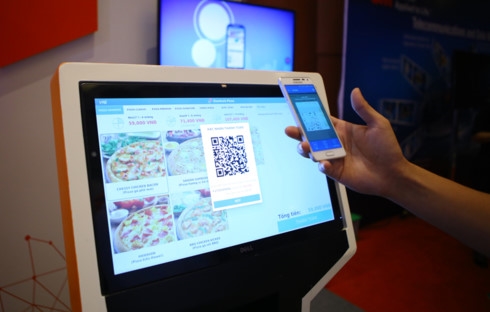Addressing a recent workshop, Dung stressed the need to upgrade and integrate the information technology systems of public service providers in order to make them compatible with payment solutions.
    |
 |
|
Cashless payment has emerged as an inevitable trend of the domestic financial and monetary markets as non-cash consumption has witnessed a string of positive changes, especially in major cities. |
Cashless payment has emerged as an inevitable trend of the domestic financial and monetary markets as non-cash consumption has witnessed a string of positive changes, especially in major cities. Elsewhere, credit institutions have begun diversifying products dedicated to enterprises and public units with non-cash transactions.
Over the past few years, e-wallets have become more familiar to urban residents, particularly young people. It is now common among young consumers to use e-wallets as a means of payment for most of their expenses, especially those for ride hailing services, shopping, and drink orders.
E-wallet providers have teamed up with commercial banks to increase their network of users while installing additional e-wallet acceptance points to better meet the needs of customers.
“How to change the habits of consumers remains a challenging issue. It comes as a positive sign that the number of e-wallet providers is increasing while the Government is pushing for the development of e-payment," said Nguyen Ba Diep, Vice Chairman of MoMo e-wallet provider.
Credit institutions have been strongly involved in promoting e-payment methods through expanding their network of card users and developing new card products for businesses, notably customer (C) to business (B) services and B to B ones.
In fact, cash management costs enterprises 4.7 to 15 per cent of their total expenses, while 92 per cent of their orders are made manually, costing them an additional 5 per cent, said Le Thi Diem Phuong, senior manager of the small and medium - sized enterprise division of VPBank.
According to a report by the multinational professional services provider PwC which surveyed 27 countries, Vietnam was the fastest growing market for mobile payments in 2018 with the proportion of mobile payment consumers increasing from 37 per cent to 61 per cent.
Last year, the country’s inter-bank electronic payment system safely handled transactions with a total value of VND73 quadrillion (US$3.13 trillion), a hike of 25 per cent on year. Most notably, mobile payments leaped by 169.5 per cent in value compared to the previous year.
There are many advantages to boost e-payments via the internet and mobile phones nationwide. In a bid to bolster the development of such payment methods, the central bank should continue to direct commercial banks and payment service providers to raise public awareness of e-payment related benefits. They are also being encouraged to increase the use of leading-edge banking and finance technologies in operations.
The adoption of cashless payments will definitely go up if non-cash payments are used for public services such as health care and education, rather than regular electricity and water bills.
Deputy Prime Minister Vuong Dinh Hue noted that the rapid growth of cashless payments, which is believed to further bolster the development of services, would help to shorten the gap between Vietnam and regional peers.
A vast adoption of non-cash payments is needed to accelerate the implementation of a comprehensive financial strategy with no one left behind.
Source: VOV